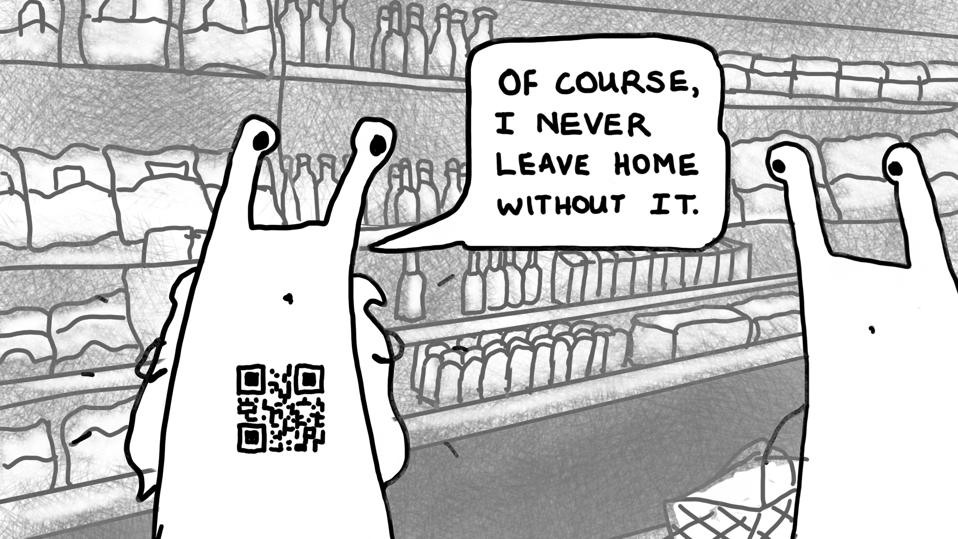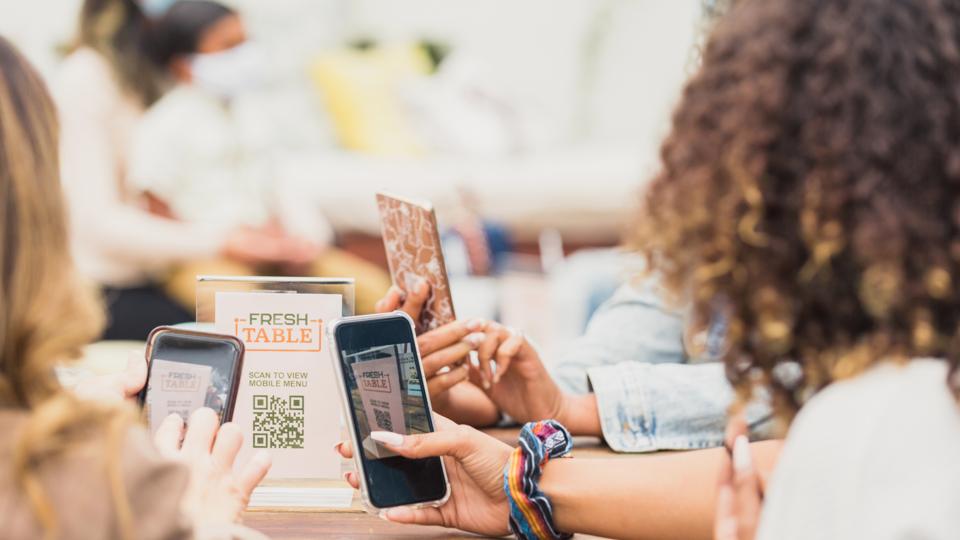As I recall, some of the delegates at the 2016 blockchain conference Consensus were sceptical when I shared my preferred strategy for securing my cryptocurrency, which was to convert the security key into a QR code and have it tattooed onto my scrotum. You could see them wondering about my grasp of the relevant risk models and questioning my confidence in the technology. I was not dismayed by their negative reaction. In fact, I had suggested this approach to managing privates keys (sic) before and had even toyed with the idea of patenting this breakthrough in cyber defence, on the grounds that you can patent anything no matter how trivial and obvious these days, but sadly I never got round to it. Now I am kicking myself, because I read in the New York Times that numerous people of an innovative bent have indeed had QR code tattoos and guess what... they work.

Helen Holmes (Instagram @TheOfficeMuse).
Everyone uses QR codes now. I mean that everyone uses QR codes in the UK (and the USA) now, whereas in the old days it was everyone in China.
There are two main reasons for this: COVID-19 and Apple. A couple of years ago, Apple changed the iPhone software so that you could scan QR codes with your iPhone camera and not have to run a separate app. At a stroke, gazillions of people gained the ability to automagically engage in contact-free transactions, while shortly afterwards along came a pandemic that accelerated the demand for contact-free transactions for everything, not only for shopping, and scanning went into overdrive.
Well it's not all down to Apple, of course. The cameras in mobile phones have improved across the board so that QR codes can be scanned clearly from a safe distance so that consumers can stand a couple of metres away from the point of sale and buy without using cash, but there’s no doubt that the iPhone convenience created the potential for a new mass market.
MORE FOR YOU
Just look around and see how quickly the technology has accelerated in coffee shops and cafes, pubs and clubs, fast food and just about everywhere else. At the cafe near me, the transformation was overnight. Now you sit down, scan a QR code and order on your phone, then a server brings you your food and drink. And when you’ve finished, you just get up and walk out. And that last point, the ability to pay and go instead of waiting for and then paying a bill, is a delight for customers and premises alike. One US technology provider has measured that this saves saves 21 minutes of table time on average and, as they note, that’s great for a restaurant “because they have the ability to increase their revenue per hour per seat" as well as removing the need to touch devices and keypads (which is why so much of the restaurant industry's investments in in-store tech has gone toward contactless payment solutions through QR codes).
Checking In
Pubs to one side, the place where I've been very interested to see the emerging dynamics is at retail point of sale (POS). A few years ago, I was of the general opinion that QR code for payments would fade away because tapping with cards or phones was quicker and more secure. But one retailer after another began to start using QR instead of NFC, partly because they didn't want consumers to have to understand how to turn on and use NFC in smartphones and partly because Apple wouldn't let them access payment interfaces in iPhones anyway. When the biggest retailers decided to go QR instead of contactless, you could see which way the wind was blowing. Walmart, to take the obvious example, introduced QR into Walmart Pay. Instead of selecting Walmart Pay at checkout, customers can now scan a QR code and Walmart Pay is connected so that customers can pay contact-free.
Another assumption, going back five years or so, was that retailers were going to get rid of payments at POS and shift to payments inside their own apps, apps that they would use to deliver better customer services. Or, in the bumper-sticker version, "we're going from check-out to check-in". This trend has now be accelerated by the same combination of pandemic and phone technology.
You could see the trend in the development of apps by the supermarket chains in the UK, where Tesco became "the latest grocer to develop its own technology to bypass the costly Android and Apple systems" and Sainsbury's was trialling its SmartShop app which allows users to create their own shopping lists, navigate stores and make payments at dedicated kiosks. Tesco has just announced that their mobile payment app Pay+ has now taken its first billion in payments.
As with other retailers, one of the attractions for supermarket chains is that their app can combine payments, loyalty and spend tracking in one and a simple quick QR scan is all that is needed to get everything done. I'm sure this combination (and, if I remember correctly, prescriptions) is what attracts consumers to using the CVS app, where shoppers will be able to scan a QR code on their phones to pay using stored debit or credit cards, bank accounts, PayPal balance, PayPal Credit, Venmo balance or Venmo Rewards. This focus on apps at POS was an obvious strategic focus long before Tim Cook stood up on stage to explains "the benefits of Apple Pay in apps".

Colleagues meet at an outdoor restaurant during COVID-19. They are using a mobile app with QR code ... [+]
gettyI remember a Comscore survey that found that 55% of American consumers would be happy to have four or more retailer apps on their phone. For the retailers that they visit frequently (e.g., Starbucks) they will have the retailer app and use it. In other cases they will just use some third-party payment app (e.g., their bank) or a convenient wearable like a bracelet or key fob that is controlled by a third-party app. This will give retailers new opportunities to add value and new control over identity and payments.
In this in-app vision of shopping, then, I do not think that consumers will have hundreds of apps on their phones to deal with every retailer. On my phone now I have fuel app that combines payments with loyalty. My supermarket app doesn't, so I don't use it (my supermarket loyalty card is in my Apple Pay wallet). I do not need much more.
I remember something that I looked at for a UK client around the time that the first supermarket apps were launching. The overwhelming majority of household disposable income in the UK goes to a handful retailers per household. In my house, for example, a supermarket app, the fuel app, the drugstore app and my coffee app pretty much take care of things. As soon as there’s a convenience store app, then that’s almost of my weekly retail spend accounted for. It is hardly a radical prediction to say that we are seeing an omnichannel convergence to app-and-pay not tap-and-pay.
The Link LonkFebruary 06, 2021 at 04:58AM
https://www.forbes.com/sites/davidbirch/2021/02/05/forget-contactless-were-going-contact-free/
Forget Contactless, We’re Going Contact-Free - Forbes
https://news.google.com/search?q=forget&hl=en-US&gl=US&ceid=US:en

No comments:
Post a Comment